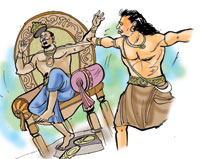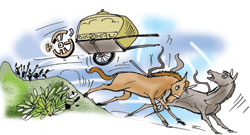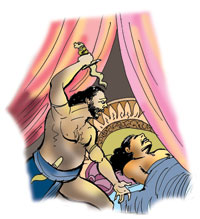1.
During the time of King Vijayabahu IV, the capital city, Dambadeniya was ruled by Prince Veerabahu. Though he had been a warrior, nothing much is written about him. Scholars point out that even the chroniclers have been silent on certain matters. But the 'Rajavaliya' records the death of King Vijayabahu. According to that, he had been at Dambadeniya. During the second year of King Vijayabahu's rule, something peculiar had
happened.
2. To wrest the power of kingship, a commander named Mitra, planned a coup-detat. He got the support of a few ministers as well. He bribed a servant of the royal household and got him to kill King Vijayabahu IV, who possessed 'Bodhisatva' qualitites (saintly). The commander Mitra, who had no claim to the throne, took up the task of overseeing the administration. Prince Buwanekabahu, the rightful successor, who was the brother of King Vijayabahu, was in Dambadeniya at this time.
3. A spy was employed to kill this prince too. This prince got into a chariot, that had no hood and fled. Spies chased behind him. The leader of the spies was a person named Munesinghe. The others were his nine brothers. They too were employed after giving them a huge bribe. They attacked the chariot in which the prince travelled. The chariot was badly damaged.
4. They attacked the chariot with such sharp weapons, that it could not go any further. The prince jumped off the chariot and hid himself. The spies returned. Later on, the prince walked all the way to Kalugala. There was a kraal there and from there he took an elephant and rode on elephant back up to Yapahuwa.
5. On his way, he had to cross the 'Kolumbune Oya.' By then the water level of the river had risen. It is with the greatest difficulty that the prince managed to cross the river and reach Yapahuwa. In the meantime, the commander Mitra had decked himself in all the royal ornaments and was seated on the throne.
He had notified the people that he was the king of Dambulla. He added that his ministers had to win the good will of the army. The army requested their salaries should be increased.
6. King Mitra agreed to this and increased their salaries. At this time, there were two sections of the army of Dambadeniya. One was called the 'Arya' army and the other the 'Sinhala' army. The chief of the Arya army was called 'Thakuraka.' He said that they did not want higher wages. It is only the Sinhala army that had requested the increase.
They wanted to meet the king. The ministers did not like the idea. When Thakuraka insisted on seeing the king, he was allowed. The Sinhala army received the increased wages without a word.
7. In spite of the ministers objecting to the idea of Thakuraka going in to the palace, the king permitted him. He took an army of about 700 soldiers and went to see the king. King Mitra welcomed them.
They were engaged in a pleasant conversation with the king. The king seemed to be highly pleased with them. At once, Thakuraka gave a signal to his army.
8. He went closer to the king to show his respect to him. The king too came closer to Thakuraka. Thakuraka worshipped the king and stood up.
At once, he pulled his sword out and with one shot cut off the head of the king. This created an uproar in the entire city of Dambadeniya.
|



